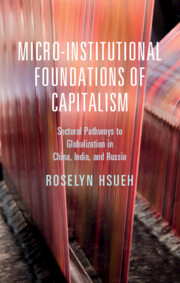Book contents
- Micro-institutional Foundations of Capitalism
- Micro-institutional Foundations of Capitalism
- Copyright page
- Dedication
- Contents
- Figures
- Tables
- Acknowledgments
- Part I Politics of Market Governance
- Part II Nations and Sectors: Patterns of Market Governance
- 3 China and Sectoral Variation
- 4 Security Imperatives, Infrastructural Development, and High-Tech Sectors
- 5 Political Stability, Local Goals, and Labor-Intensive Sectors
- 6 India and Sectoral Variation
- 7 Pro-Liberalization Transnational Business and High-Tech Services
- 8 Political Legitimacy, Economic Stability, and Labor-Intensive Small-Scale Sectors
- 9 Russia and Sectoral Variation
- 10 National Security and Infrastructure and Resource Sectors
- 11 Regional Development and Labor-Intensive Sectors
- Part III National Configurations of Sectoral Models
- Bibliography
- Index
7 - Pro-Liberalization Transnational Business and High-Tech Services
Regulated Governance in Indian Telecommunications
from Part II - Nations and Sectors: Patterns of Market Governance
Published online by Cambridge University Press: 16 June 2022
- Micro-institutional Foundations of Capitalism
- Micro-institutional Foundations of Capitalism
- Copyright page
- Dedication
- Contents
- Figures
- Tables
- Acknowledgments
- Part I Politics of Market Governance
- Part II Nations and Sectors: Patterns of Market Governance
- 3 China and Sectoral Variation
- 4 Security Imperatives, Infrastructural Development, and High-Tech Sectors
- 5 Political Stability, Local Goals, and Labor-Intensive Sectors
- 6 India and Sectoral Variation
- 7 Pro-Liberalization Transnational Business and High-Tech Services
- 8 Political Legitimacy, Economic Stability, and Labor-Intensive Small-Scale Sectors
- 9 Russia and Sectoral Variation
- 10 National Security and Infrastructure and Resource Sectors
- 11 Regional Development and Labor-Intensive Sectors
- Part III National Configurations of Sectoral Models
- Bibliography
- Index
Summary
This chapter shows how the perceived strategic value of high-tech, globally integrated sectors, represented by telecommunications, for neoliberal development interacts with sectoral structures and organization of institutions. The resultant regulated governance by the Indian government of telecommunications are the micro-institutional foundations of Indian-style capitalism undergirding the globalization and development of such industries disconnected from the post-Independence legacies of the Indian nationalist imagination. The cross-time sector and company case studies show the initial introduction of competition in telecommunications occurred during Big Bang Liberalization supported by pro-liberalization industrial stakeholders disconnected from the existing telecommunications bureaucracy. Today a central-level ministry makes policy and an independent regulator enforces the market entry and business scope of a state-owned fixed-line operator and fiercely competitive mobile carriers and value-added service providers. The role of the state in market coordination and the dominant property rights arrangements vary by subsector as a function of interacting strategic value and sectoral logics. Nehruvian interpretation of Gandhian Swadeshi self-reliance has retained bureaucratic oversight of the development of state- and privately-owned equipment makers, which concentrated on rural automatic exchanges and low-tech inputs until the dominance of Chinese competition pivoted focus to indigenous development in new generation mobile consumer and terminal telecommunications equipment.
Keywords
- Type
- Chapter
- Information
- Micro-institutional Foundations of Capitalism , pp. 184 - 212Publisher: Cambridge University PressPrint publication year: 2022

